![]()
![]()
![]()
Use LEFT and RIGHT arrow keys to navigate between flashcards;
Use UP and DOWN arrow keys to flip the card;
H to show hint;
A reads text to speech;
27 Cards in this Set
- Front
- Back
|
General characteristics of emerging viruses?
|
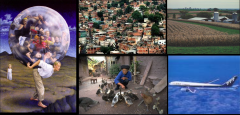
-Most are zoonotic.
-Human behavior increases the probability of transfer from their endogenous animal hosts to man -Overpopulation, overcrowding, global warming, etc. |
|
|
Examples of zoonotic viruses in exotic pets?
|

|
|
|
What are arboviruses?
what 3 groups of arboviruses are there? what type of virus are they? |
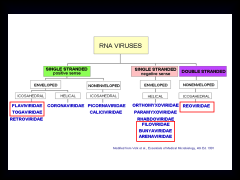
-Arthropod-borne
-Transmitted by means of an infected blood-sucking arthropod. -Virus replicates in the arthropod vector. -Virus is usually maintained in a vertebrate host. -Humans are usually incidental hosts; exceptions include yellow fever and dengue. -Most arboviruses belong to the Togaviridae (alphaviruses), Flaviviridae, and Bunyaviridae families. -All are RNA viruses. |
|

|
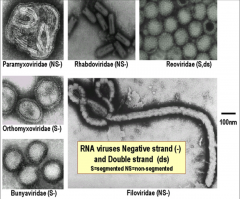
Arboviruses:
|
|
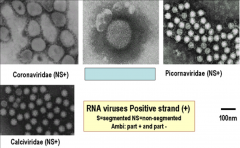
|

|
|
|
Life cycle of arboviruses?
-1˚ and incidental hosts? -impact of environment? |
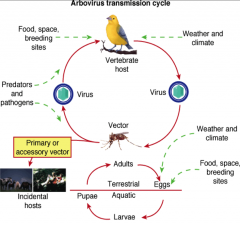
|
|
|
SPECIFIC CYCLES OF ARBOVIRUS TRANSMISSION: 3
|
URBAN
SYLVATIC ARTHROPOD-SUSTAINED |
|
|
Describe the urban cycle:
-vector -2 disease examples |
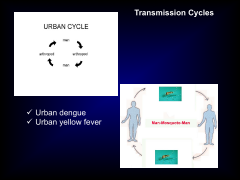
*mosquitoes
|
|
|
Describe the jungle cycle:
-vectors -2 disease examples |
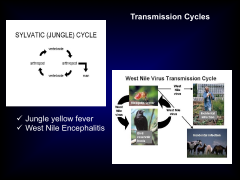
|
|
|
Most arboviruses are transmitted to humans by ____ inoculation. What are some exceptions to this?
|
-DIRECT
-Exception: unpasteurized milk can transmit viruses to humans. |
|
|
Describe DISEASE SYNDROMES OF THE ALPHAVIRUSES AND FLAVIVIRUSES:
|
-Primary viremia may be associated with mild systemic disease.
-If sufficient virus is produced during the secondary viremia to escape immune protection and to reach critical target tissues, severe systemic disease or encephalitis may result. -For dengue virus, rechallenge with another strain can result in severe dengue hemorrhagic fever (DHF), which can cause dengue shock syndrome (DSS). |
|
|
3 severe disease outcomes that may result from alphaviruses/flaviviruses?
|

1) encephalitis
2) hemorrhagic fevers 3) non-hemorrhagic fevers |
|
|
What's an example of an arbovirus with crazy mortality?
What type of arbovirus is it? |
-EEE is an alphavirus
-Carried by mosquitoes, wild birds, horses -50% fatality |
|
|
West Nile Encephalitis cycle:
|
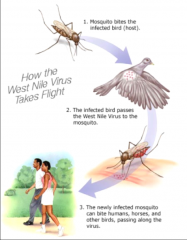
-Caused by a Flavivirus
-In 2004, virus was found in all states except Washington. -Natural reservoir of the virus is birds and the virus is transmitted by mosquitoes ( Culex sp.). |
|
|
Disease course in WNV?
What determines outcome? |
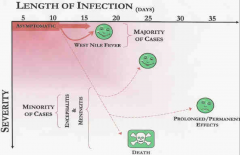
-Immune status of host determines outcome.
|
|
|
Dengue Virus key points:
-type of virus? -vectors -cycle locations -common fever associated with it? |
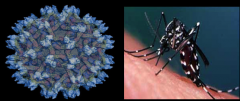
-Caused by a flavivirus.
-Monkeys and humans are natural hosts, mosquitoes are the vectors. -Has both urban and sylvatic cycle. -Four serotypes!! -Major worldwide problem; virus can be imported into U.S. by travelers. -Fever, headache, rash, bone pain = “Breakbone Fever” |
|
|
Where in the world do we see dengue?
|
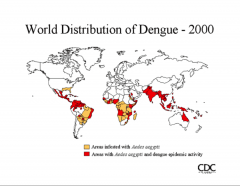
|
|
|
Describe dengue hemorrhagic fever:
|
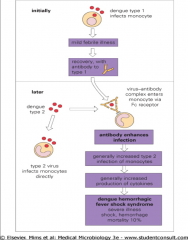
-Abs against one serotype of dengue make a horrible cross-reaction with a second serotype of dengue.
-Fc receptor binds to monocytes and facilitates entry of second serotype into cell. -A hypersensitivity response occurs --> vascular destruction, shock. -This is BAD. |
|
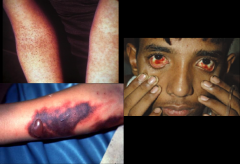
|
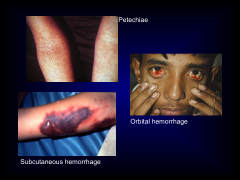
dengue hemorrhagic fever!
|
|
|
Rodent-Borne Pathogens:
|

Hanta is key
|
|
|
What vector carries the arenaviruses?
|
-Rodents
|
|
|
Key points about Hantavirus:
-what is its genera and why is it unique among them? -vectors? -transmission? -2 bad disease outcomes? |
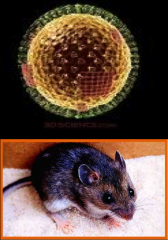
-No arthropod vector established; Unique among genera Bunyaviridae
-Rodent hosts--Genus and possible species specific -Transmission by Aerosolization of rodent excretra -Associated with hemorrhagic fever with renal syndrome (HFRS) and severe pulmonary syndrome (HPS). ~30% fatality |
|
|
Describe transmission of hanta virus?
|
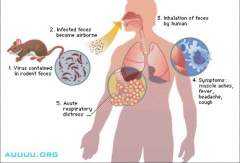
|
|
|
Key points about Filoviridae:
-reservoir? -2 virus examples? -how does it damage humans? -mortality -transmission |
-Reservoir is unknown
-Pleomorphic; generally seen as long filamentous, enveloped particles that may be branched. -Ebola and Marburg viruses -Cause severe hemorrhagic fever (lysis of endothelial cells by a viral surface glycoprotein), characterized by widespread bleeding into the skin, mucous membranes, visceral organs, and GI tract. -Mortality rate is high (60-90%) -Can be transmitted to humans from infected monkeys and probably other animals, or by exposure to the blood or other body fluids from an infected patient. |
|
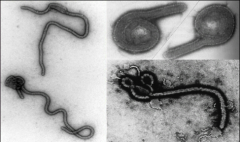
|
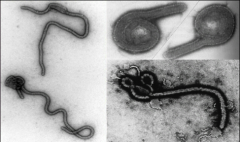
-Filovirus
-Unique filamentous appearance |
|
|
Pathogenesis of Ebola damage:
|
-Ebola Zaire attacks every organ and tissue in the human body except skeletal muscle and bone.
-Small blood clots begin to appear in the bloodstream, and the blood thickens and slows, and clots begin to stick to the walls of blood vessels. |
|
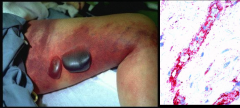
|
-Damage from the Ebola Virus
-Attacks endothelial cells and lyses them -"Melts" you from the inside out. |

